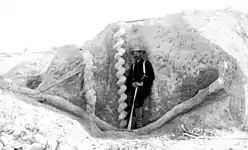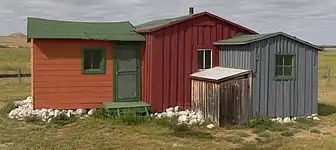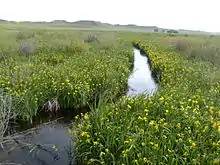Agate Fossil Beds National Monument
Agate Fossil Beds National Monument is a U.S. National Monument near Harrison, Nebraska. The main features of the monument are a valley of the Niobrara River and the fossils found on Carnegie Hill and University Hill.
| Agate Fossil Beds National Monument | |
|---|---|
IUCN category III (natural monument or feature) | |
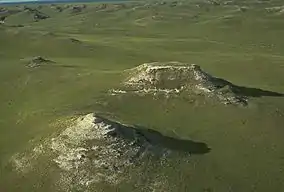 University and Carnegie Hills fossil beds | |
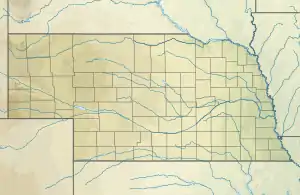  | |
| Location | Sioux County, Nebraska, United States |
| Nearest city | Harrison, NE |
| Coordinates | 42.421703°N 103.75388°W[1] |
| Area | 3,057.87 acres (12.3748 km2)[2] |
| Established | June 14, 1997 |
| Visitors | 15,555 (in 2016)[3] |
| Governing body | National Park Service |
| Website | Agate Fossil Beds National Monument |
The area largely consists of grass-covered plains. Plants on the site include prairie sandreed, blue grama, little bluestem and needle and thread grass, and the wildflowers lupin, spiderwort, western wallflower and sunflowers.
History
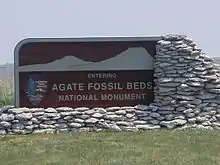
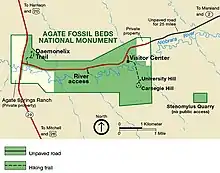
The site is best known for the large number of well-preserved Miocene fossils, many of which were found at dig sites on Carnegie and University Hills. Fossils from the Harrison Formation and Anderson Ranch Formation, which date to the Arikareean in the North American land mammal classification, about 20 to 16.3 million years ago, are among some of the best specimens of Miocene mammals. Species found at Agate include:
- Miohippus, an ancestor of the modern horse
- Menoceras, a pony-sized rhinoceros
- Daphoenodon, a bear dog
- Daeodon, the largest Entelodont (giant pig-like ungulate)
- Stenomylus, a gazelle-like camelid
- Palaeocastor, land beavers that dug large corkscrew-shaped burrows (Daemonelix)
- Moropus, a chalicothere which are relatives of rhinos and horses
Originally the Agate Springs Ranch, a working cattle ranch, was owned by Capt. James Cook. The monument's museum collection also contains more than 500 artifacts from the Cook Collection of Plains Indians artifacts.
The national monument was authorized on June 5, 1965, but was not established until June 14, 1997. The Harold J. Cook Homestead (Bone Cabin Complex) was listed on the National Register of Historic Places in 1977.[4] Agate Fossil Beds is maintained by the National Park Service.[5]
In popular culture
The Agate Fossil Beds National Monument will feature in the upcoming documentary Forgotten Bloodlines: Agate, slated for release in 2022.[6]
Gallery
|
See also
References
- The National Parks: Index 2001–2003. Washington: U.S. Department of the Interior.
- "Agate Fossil Beds National Monument". Geographic Names Information System. United States Geological Survey. Retrieved November 18, 2013.
- "Listing of acreage as of December 31, 2011". Land Resource Division, National Park Service. Retrieved March 18, 2012.
- "NPS Annual Recreation Visits Report". National Park Service. Retrieved May 19, 2017.
- "Nebraska National Register Sites in Sioux County". Nebraska State Historical Society. Archived from the original on October 19, 2013. Retrieved October 18, 2013.
- "Agate Fossil Beds National Monument". U.S. National Park Service. Archived from the original on December 2, 2009. Retrieved December 16, 2009.
- https://twitter.com/digital_duck/status/1342528096176635907
External links
| Wikimedia Commons has media related to Agate Fossil Beds National Monument. |
- Official NPS website: Agate Fossil Beds National Monument
